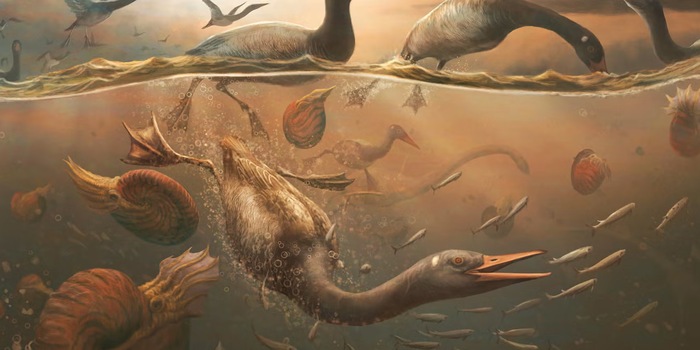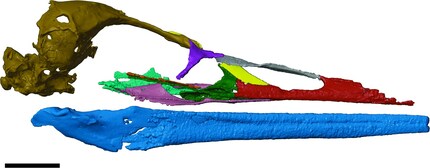
Oldest modern bird found
Examination of a fossilised bird skull reveals that the animal shared its habitat with the dinosaurs of the Mesozoic era, but was already a modern bird.
The oldest known representative of modern birds belonged to the goose family (Anseriformes) and probably hunted in bodies of water. With its long, pointed beak and powerful jaw muscles, it probably caught fish and other prey by propelling itself underwater with its feet - a hunting strategy similar to that of today's grebes. The animal lived 69 million years ago and was therefore a contemporary of Tyrannosaurus rex. Experts led by Christopher Torres from Ohio University have examined a fossilised skull of the prehistoric goosebird and report on it in the scientific journal "Nature".
The fossilised skull was found back in 2011 during a research expedition to Antarctica. It is largely preserved and belongs to the extinct bird species Vegavis iaai. The research group analysed the bone remains using computed tomography and reconstructed what it looked like when it was alive. This allows the species to be categorised in the family tree of modern birds.
Vegavis iaai stood about half a metre tall, had a narrow, toothless beak and a comparatively voluminous cerebrum. These and other characteristics correspond to those of modern waterfowl. Unlike these, the fossilised skull shows traces of powerful jaw muscles, which the prehistoric bird apparently needed for underwater hunting. Other fossil finds of representatives of its species suggest that Vegavis iaai catapulted itself forwards in the water by thrusting its feet backwards.

Source: © C. Torres, Ohio University and J. Gronke, University of the Pacific; Torres, R.C. et al.: Cretaceous Antarctic bird skull elucidates early avian ecological diversity. Nature 638, 2025, Extended Data fig. 5a (excerpt)
According to dating data, the prehistoric goose bird lived in the area that is now Antarctica during the Cretaceous period. At that time, it was not covered in snow and ice, but had a temperate climate with lush vegetation and wildlife. Dinosaurs also lived there.
The study by Torres and his team could help to put an end to years of debate about how Vegavis iaai is related. Fossil remains of this animal have been known to experts for some time and were initially categorised as early ducklings. However, further investigations have cast doubt on this. According to the new analysis by Torres & Co., the extinct species belongs to the modern birds (Neornithes) and was an early representative of the goose birds. If the age of 69 million years is confirmed, it would be the oldest known modern bird species
Spectrum of science
We are partners of Spektrum der Wissenschaft and want to make well-founded information more accessible to you. Follow Spektrum der Wissenschaft if you like the articles.
Original article on Spektrum.de
Experts from science and research report on the latest findings in their fields – competent, authentic and comprehensible.
From the latest iPhone to the return of 80s fashion. The editorial team will help you make sense of it all.
Show all